External interrupt
External hardware interrupt
For the interrupt signal from the outside of the processor, the external hardware interrupt is introduced into the processor through two signal lines, and the signal lines of 8086 processor are NMI and INTR
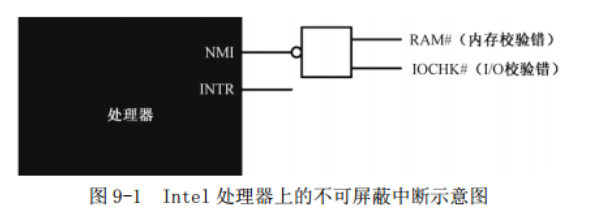
- Non masked interrupt (NMI) is an interrupt that will not be blocked or masked. intel processor stipulates that NMI interrupt signal must be maintained for more than 4 clock cycles after jumping from 0 to 1. The interrupt number of NMI in real mode is 2
- It can mask interrupts. intel processor allows 256 interrupts, and 8259 chip (interrupt controller) provides 15 of them
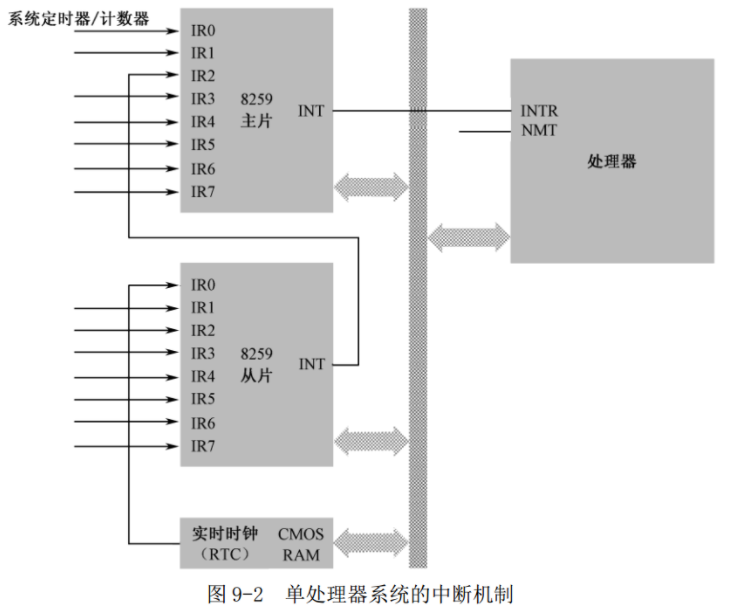
There is an interrupt mask register IMR in the 8259, which corresponds to 8 pins, which determines that this pin can transmit the interrupt signal to the processor. Whether the interrupt can be processed depends on the IF bit of the flag register, which is set through cli and sti
Interrupt vector table (real mode)
In real mode, the entry point of the interrupt handler is 0x00000 to 0x003ff of the physical address of the memory, with a total space of 1KB, that is, the interrupt vector table
Each interrupt occupies a double word in the interrupt vector table
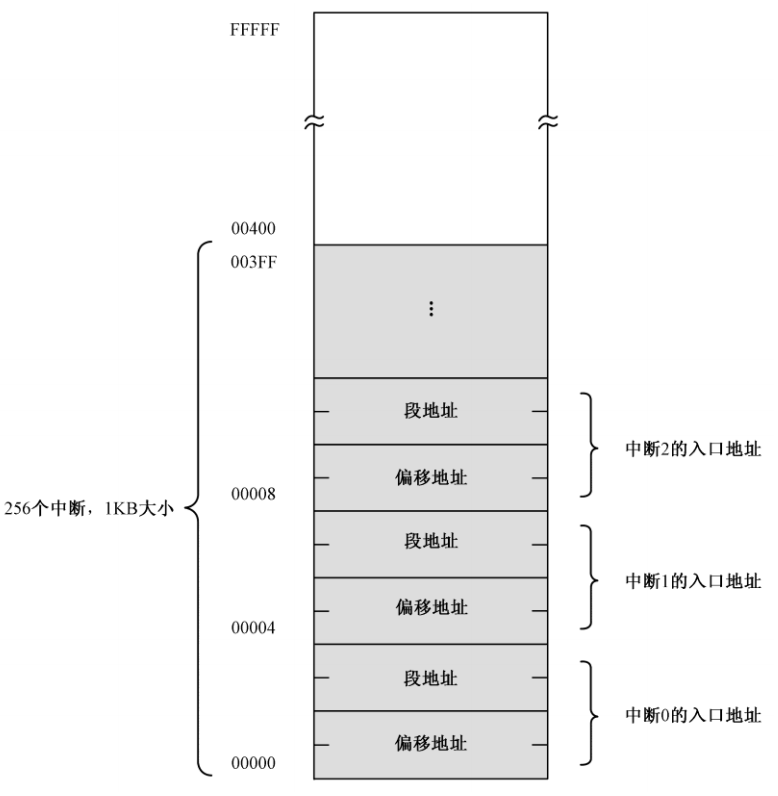
Process for handling interrupts:
- Protect the breakpoint site, stack the flag register FLAGS, clear IF (interrupt flag) and TF (trap flag), and stack CS and IP
- Execute the interrupt program, multiply the obtained terminal number by 4 in the interrupt vector table, take out the offset address and segment address of the interrupt program, and transmit CS and IP. At this time, because the IF flag is cleared, the processor will no longer respond to the interrupt during interrupt processing
- Return to the breakpoint to continue execution. The last instruction of the interrupt handler is iret. The processor successively exits the stack CS and IP and marks the register area
Interrupts can occur at any time, so the interrupt vector table is completed by BIOS when the computer starts
Real time clock
In the peripheral device control chip ICH, real-time clock circuit RTC and static memory CMOS RAM are integrated
The date and time information is stored in CMOS RAM, usually 128 bytes, while the date and time information only accounts for a small part of the capacity. Other space is used to save the configuration information of the whole machine, such as the type and working parameters of various hardware, startup password and startup sequence of auxiliary storage devices.
The RTC chip is driven by a quartz crystal oscillator (crystal oscillator) with an oscillation frequency of 32.768kHz. After frequency division, it is used to refresh the CMOS RAM once per second
CMOS RAM needs to be accessed through two ports. 0x70 or 0x74 is the index port, which is used to specify the unit in CMOS RAM; 0x71 or 0x75 is the data port used to read and write the contents of the corresponding unit
;Read week mov al,0x06 out 0x70,al in al,ox71
From a very early time, the highest bit (bit 7) of port 0x70 is the switch that controls NMI interrupt. When it is 0, NMI interrupt is allowed to reach the processor. When it is 1, all NMI signals are blocked. The other 7 bits, i.e. 0 ~ 6 bits,
It is actually used to specify the index number of CMOS RAM unit. Although bit 7 of port 0x70 is not an interrupt signal, it can control the output of NAND gate and determine whether the real NMI interrupt signal can reach the processor.
In the early system, the manufacturing cost of computer was very high. In order to maximize the use of hardware resources, this strange practice was caused,
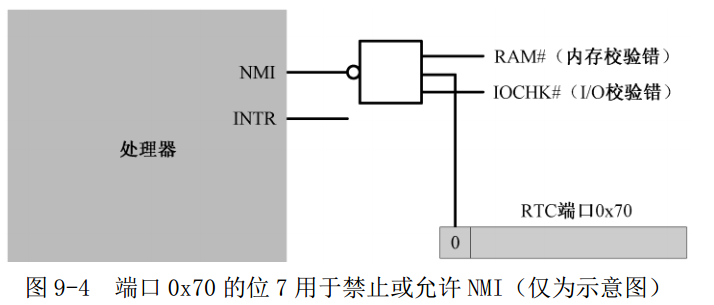
The date and time saved in CMOS RAM are usually Binary Coded Decimal (BCD)
Units 0x0A ~ 0x0D are not ordinary storage units, but are defined as index numbers of four registers, which are also accessed through ports 0x70 and 0x71. These four registers are used to set the parameters and working status of the real-time clock circuit
Registers A and B are used to set the functions of RTC as A whole. Refer to P156 for details
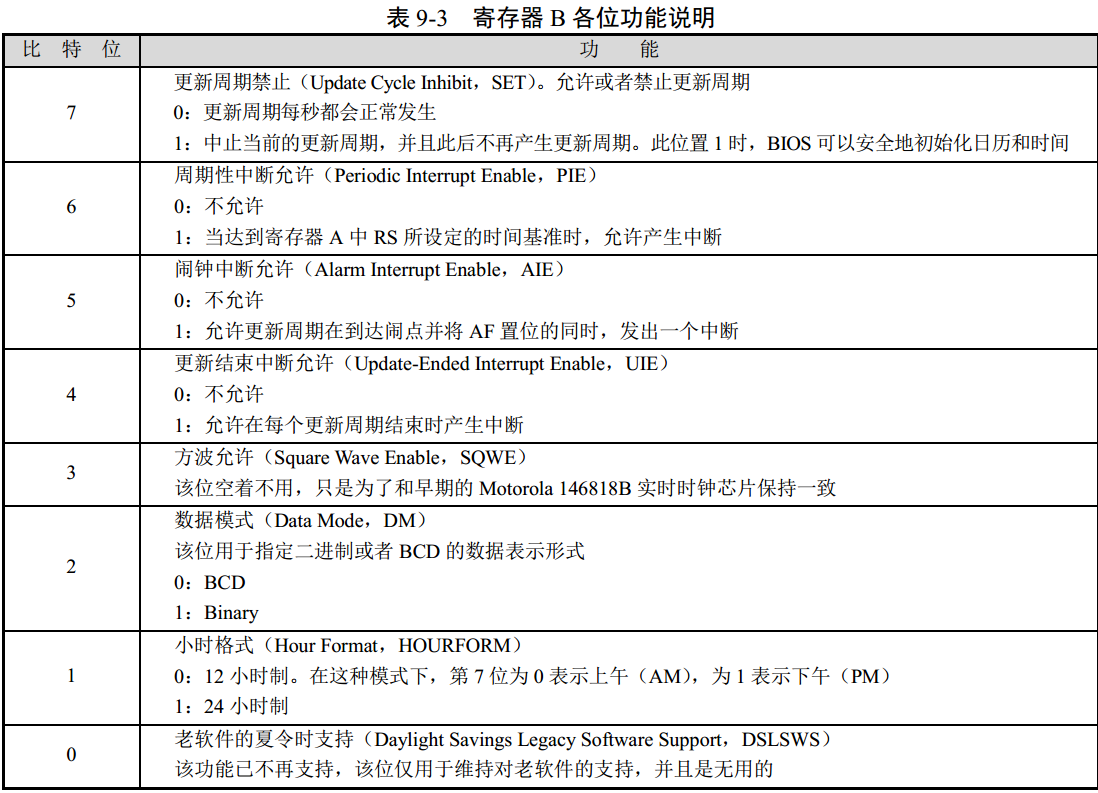
Each time an interrupt actually occurs, the contents of register C can be read in the program (interrupt processing process) to check the cause of the interrupt. Another feature of this register is that every time it is read, all contents are automatically cleared. Moreover, if it is not read (in other words, the corresponding bit is not cleared), the same interrupt will no longer be generated.
Program objective: RTC chip sends interrupt regularly, executes code and reads CMOS RAM information
User program
Note: when the processor is designed, it is specified that when an instruction modifying the segment register SS is encountered, interrupt is prohibited during the execution of this instruction and the next instruction, so as to protect the stack
After the computer starts, the interrupt number of RTC chip is 0x70 by default
;Code listing 9-1
;File name: c09_1.asm
;File Description: user program
;Date of creation: 2011-4-16 22:03
;===============================================================================
SECTION header vstart=0 ;Define user program header segment
program_length dd program_end ;Total program length[0x00]
;User program entry point
code_entry dw start ;Offset address[0x04]
dd section.code.start ;Segment address[0x06]
realloc_tbl_len dw (header_end-realloc_begin)/4
;Number of segment relocation table entries[0x0a]
realloc_begin:
;Segment relocation table
code_segment dd section.code.start ;[0x0c]
data_segment dd section.data.start ;[0x14]
stack_segment dd section.stack.start ;[0x1c]
header_end:
;===============================================================================
SECTION code align=16 vstart=0 ;Define code snippets (16 byte alignment)
new_int_0x70:
push ax
push bx
push cx
push dx
push es
.w0:
mov al,0x0a ;block NMI. Of course, it is usually unnecessary
or al,0x80
out 0x70,al
in al,0x71 ;Read register A
test al,0x80 ;Test bit 7 UIP
jnz .w0 ;The above code is for the end of the update cycle interrupt
;be not necessary
xor al,al
or al,0x80
out 0x70,al
in al,0x71 ;read RTC current time (second)
push ax
mov al,2
or al,0x80
out 0x70,al
in al,0x71 ;read RTC current time (branch)
push ax
mov al,4
or al,0x80
out 0x70,al
in al,0x71 ;read RTC current time (Time)
push ax
mov al,0x0c ;register C Index of. And open NMI
out 0x70,al
in al,0x71 ;Read it RTC Register of C,Otherwise, only one interrupt occurs
;Alarms and periodic interruptions are not considered here
mov ax,0xb800
mov es,ax
pop ax
call bcd_to_ascii
mov bx,12*160 + 36*2 ;Start with 12 rows and 36 columns on the screen
mov [es:bx],ah
mov [es:bx+2],al ;Display two hour numbers
mov al,':'
mov [es:bx+4],al ;Display separator':'
not byte [es:bx+5] ;Reverse display properties
pop ax
call bcd_to_ascii
mov [es:bx+6],ah
mov [es:bx+8],al ;Displays a two digit minute number
mov al,':'
mov [es:bx+10],al ;Display separator':'
not byte [es:bx+11] ;Reverse display properties
pop ax
call bcd_to_ascii
mov [es:bx+12],ah
mov [es:bx+14],al ;Display two hour numbers
mov al,0x20 ;Interrupt end command EOI
out 0xa0,al ;Send to slave
out 0x20,al ;Send to master
pop es
pop dx
pop cx
pop bx
pop ax
iret
;-------------------------------------------------------------------------------
bcd_to_ascii: ;BCD Code conversion ASCII
;Input: AL=bcd code
;Output: AX=ascii
mov ah,al ;Split into two numbers
and al,0x0f ;Only the lower 4 bits are reserved
add al,0x30 ;convert to ASCII
shr ah,4 ;Logical shift right 4 bits
and ah,0x0f
add ah,0x30
ret
;-------------------------------------------------------------------------------
start:
mov ax,[stack_segment]
mov ss,ax
mov sp,ss_pointer
mov ax,[data_segment]
mov ds,ax
mov bx,init_msg ;Display initial information
call put_string
mov bx,inst_msg ;Display installation information
call put_string
mov al,0x70
mov bl,4
mul bl ;Calculate 0 x70 No. interrupt at IVT Offset in
mov bx,ax
cli ;Prevent new 0 during changes x70 No. interrupt
push es
mov ax,0x0000
mov es,ax
mov word [es:bx],new_int_0x70 ;Offset address.
;Write the address of the interrupt handler to the interrupt vector table
mov word [es:bx+2],cs ;Segment address
pop es
mov al,0x0b ;RTC register B
or al,0x80 ;block NMI
out 0x70,al
mov al,0x12 ;Set register B,Periodic interruption is prohibited and more open
out 0x71,al ;Interrupt after new, BCD Yard, 24-hour system
mov al,0x0c
out 0x70,al
in al,0x71 ;read RTC register C,Reset pending interrupt status
;RTC After the chip is set, the 8259 will not be allowed RTC Interrupt, you need to modify its internal interrupt mask register IMR.
;IMR Is an 8-bit register, and bit 0 corresponds to the interrupt input pin IR0,Bit 7 corresponds to the pin IR7,When the corresponding bit is 0, interrupt is allowed, and when it is 1, interrupt is turned off
in al,0xa1 ;Read 8259 from the film IMR register
and al,0xfe ;eliminate bit 0(This bit is connected RTC)
out 0xa1,al ;Write back to this register
sti ;Reopen interrupt
mov bx,done_msg ;Display installation completion information
call put_string
mov bx,tips_msg ;Display prompt information
call put_string
mov cx,0xb800
mov ds,cx
mov byte [12*160 + 33*2],'@' ;Screen line 12, column 35
.idle:
hlt ;send CPU Enter the low power state until you wake up with an interrupt
not byte [12*160 + 33*2+1] ;Reverse display properties
jmp .idle
;-------------------------------------------------------------------------------
put_string: ;Display string(0 ending).
;Input: DS:BX=String address
mov cl,[bx]
or cl,cl ;cl=0 ?
jz .exit ;Yes, return to the main program
call put_char
inc bx ;Next character
jmp put_string
.exit:
ret
;-------------------------------------------------------------------------------
put_char: ;Display one character
;Input: cl=character ascii
push ax
push bx
push cx
push dx
push ds
push es
;Take the current cursor position below
mov dx,0x3d4
mov al,0x0e
out dx,al
mov dx,0x3d5
in al,dx ;High 8 bits
mov ah,al
mov dx,0x3d4
mov al,0x0f
out dx,al
mov dx,0x3d5
in al,dx ;Lower 8 bits
mov bx,ax ;BX=16 digits representing cursor position
cmp cl,0x0d ;Carriage return?
jnz .put_0a ;no See if there are characters such as line breaks
mov ax,bx ;
mov bl,80
div bl
mul bl
mov bx,ax
jmp .set_cursor
.put_0a:
cmp cl,0x0a ;Newline?
jnz .put_other ;No, then display the characters normally
add bx,80
jmp .roll_screen
.put_other: ;Normal display character
mov ax,0xb800
mov es,ax
shl bx,1
mov [es:bx],cl
;Next, advance the cursor position one character
shr bx,1
add bx,1
.roll_screen:
cmp bx,2000 ;Cursor out of screen? Scroll screen
jl .set_cursor
mov ax,0xb800
mov ds,ax
mov es,ax
cld
mov si,0xa0
mov di,0x00
mov cx,1920
rep movsw
mov bx,3840 ;Clear the bottom line of the screen
mov cx,80
.cls:
mov word[es:bx],0x0720
add bx,2
loop .cls
mov bx,1920
.set_cursor:
mov dx,0x3d4
mov al,0x0e
out dx,al
mov dx,0x3d5
mov al,bh
out dx,al
mov dx,0x3d4
mov al,0x0f
out dx,al
mov dx,0x3d5
mov al,bl
out dx,al
pop es
pop ds
pop dx
pop cx
pop bx
pop ax
ret
;===============================================================================
SECTION data align=16 vstart=0
init_msg db 'Starting...',0x0d,0x0a,0
inst_msg db 'Installing a new interrupt 70H...',0
done_msg db 'Done.',0x0d,0x0a,0
tips_msg db 'Clock is now working.',0
;===============================================================================
SECTION stack align=16 vstart=0
resb 256
ss_pointer:
;===============================================================================
SECTION program_trail
program_end:
Internal interrupt
Internal interrupts occur inside the processor and are caused by executed instructions. When the divisor of div or idiv instruction is zero or the result of division overflows, an interrupt 0 (interrupt 0) will be generated, which is the division error interrupt
Internal interrupts are not affected by the IF bit of the flag register and do not need to interrupt to identify the bus cycle. Their interrupt type is fixed and can be immediately transferred to the corresponding processing process.
Soft interrupt
Soft interrupt is an interrupt processing caused by int instruction
int3 int imm8 into
int3 is a breakpoint interrupt instruction
int3 and int 3 are not the same thing
into is an overflow interrupt instruction. When the processor executes this instruction, if the OF bit OF the flag register is 1, then interrupt No. 4 will be generated. Or do nothing
BIOS interrupt
BIOS interrupts because these interrupt functions are established during the execution of BIOS program after the computer is powered on
BIOS may provide initialization code and function call code for some simple peripheral devices and fill in the interrupt vector table, but some BIOS interrupts are established by the external device interface itself.
- Each external device interface, including various boards, such as network card, graphics card, keyboard interface circuit, hardware controller, etc., has its own Read Only Memory (ROM), similar to BIOS chip. These ROMs provide its own function call routine and the initialization code of the device. According to the specification, the contents of the first two units are 0x55 and 0xAA, and the third unit is the code length in 512 bytes in this ROM; Starting with the fourth unit, it is the actual ROM code.
- From the memory physical address A0000 to the end of FFFFF, a considerable part of the space is reserved for peripheral devices. If the device exists, its own ROM will be mapped to the address range assigned to it
- The BIOS program will search the area between memory addresses C0000 and E0000 in 2KB. When the first two bytes of an area are 0x55 and 0xAA, it means that there is ROM code in the area. It then accumulates and checks the area to see if the result matches the third unit. If it matches, enter from the fourth unit. At this time, the processor executes the program instructions of the hardware. These instructions initialize the relevant registers and working states of the external device. Finally, fill in the relevant interrupt vector table to point to the built-in interrupt processing process.
User program
;===============================================================================
SECTION header vstart=0 ;Define user program header segment
program_length dd program_end ;Total program length[0x00]
;User program entry point
code_entry dw start ;Offset address[0x04]
dd section.code.start ;Segment address[0x06]
realloc_tbl_len dw (header_end-realloc_begin)/4
;Number of segment relocation table entries[0x0a]
realloc_begin:
;Segment relocation table
code_segment dd section.code.start ;[0x0c]
data_segment dd section.data.start ;[0x14]
stack_segment dd section.stack.start ;[0x1c]
header_end:
;===============================================================================
SECTION code align=16 vstart=0 ;Define code snippets (16 byte alignment)
start:
mov ax,[stack_segment]
mov ss,ax
mov sp,ss_pointer
mov ax,[data_segment]
mov ds,ax
mov cx,msg_end-message
mov bx,message
.putc:
mov ah,0x0e
mov al,[bx]
int 0x10
inc bx
loop .putc
.reps:
mov ah,0x00
int 0x16
mov ah,0x0e
mov bl,0x07
int 0x10
jmp .reps
;===============================================================================
SECTION data align=16 vstart=0
message db 'Hello, friend!',0x0d,0x0a
db 'This simple procedure used to demonstrate '
db 'the BIOS interrupt.',0x0d,0x0a
db 'Please press the keys on the keyboard ->'
msg_end:
;===============================================================================
SECTION stack align=16 vstart=0
resb 256
ss_pointer:
;===============================================================================
SECTION program_trail
program_end: